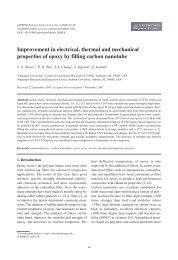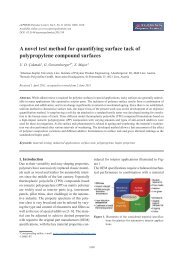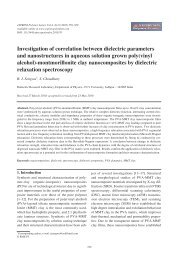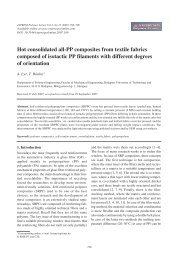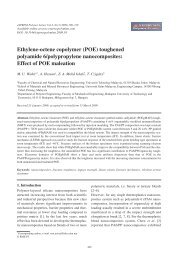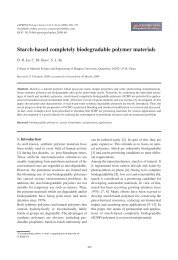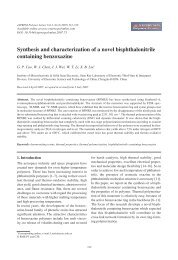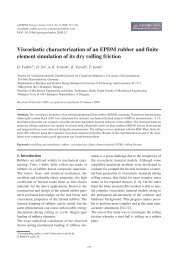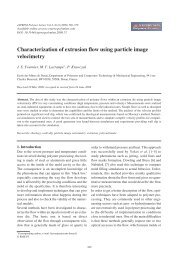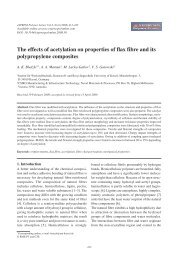Nanotechnology and its applications in lignocellulosic composites, a ...
Nanotechnology and its applications in lignocellulosic composites, a ...
Nanotechnology and its applications in lignocellulosic composites, a ...
Create successful ePaper yourself
Turn your PDF publications into a flip-book with our unique Google optimized e-Paper software.
Kamel – eXPRESS Polymer Letters Vol.1, No.9 (2007) 546–575<br />
Where the physical, chemical, or biological properties<br />
are fundamentally different from those of the<br />
bulk material. By exp<strong>and</strong><strong>in</strong>g our underst<strong>and</strong><strong>in</strong>g <strong>and</strong><br />
control of matter at such levels, new avenues <strong>in</strong><br />
product development can be opened [2].<br />
<strong>Nanotechnology</strong> can be def<strong>in</strong>ed as the science <strong>and</strong><br />
eng<strong>in</strong>eer<strong>in</strong>g <strong>in</strong>volved <strong>in</strong> the design, synthesis, characterization,<br />
<strong>and</strong> application of materials <strong>and</strong><br />
devices whose smallest functional organization <strong>in</strong><br />
at least one dimension is on the nanometer scale or<br />
one billionth of a meter [3]. Classified by nanofiller<br />
dimensionality, there are a number of types of<br />
nanocompomposites. Zero-dimensional (nanoparticle),<br />
one-dimensional (nanofiber), two-dimensional<br />
(nanolayer), <strong>and</strong> three-dimensional (<strong>in</strong>terpenetrat<strong>in</strong>g<br />
network) systems can all be imag<strong>in</strong>ed [4]. Also,<br />
lamellar nano<strong>composites</strong> can be divided <strong>in</strong>to two<br />
dist<strong>in</strong>ct classes, <strong>in</strong>tercalated <strong>and</strong> exfoliated. In<br />
<strong>in</strong>tercalated nano<strong>composites</strong>, the polymer cha<strong>in</strong>s<br />
alternate with the <strong>in</strong>organic layers <strong>in</strong> a fixed compositional<br />
ratio <strong>and</strong> have def<strong>in</strong>ed number(s) of<br />
polymer layers <strong>in</strong> the <strong>in</strong>tralamellar space. In exfoliated<br />
nano<strong>composites</strong>, the number of polymer<br />
cha<strong>in</strong>s between the layers is almost cont<strong>in</strong>uously<br />
variable <strong>and</strong> the layers st<strong>and</strong> >100 Å apart. Determ<strong>in</strong><strong>in</strong>g<br />
<strong>and</strong> alter<strong>in</strong>g how materials <strong>and</strong> their <strong>in</strong>terfaces<br />
are constructed at nano- <strong>and</strong> atomic scales<br />
will provide the opportunity to develop new materials<br />
<strong>and</strong> products. Because of this ability, nanotechnology<br />
represents a major opportunity for wood<br />
<strong>and</strong> wood-based materials to improve their performance<br />
<strong>and</strong> functionality develop new generations<br />
of products, <strong>and</strong> open new market segments <strong>in</strong><br />
the com<strong>in</strong>g decades [5]. Now it is possible to ask,<br />
why nanotechnology is important.<br />
The answer is [6]:<br />
a) Less space, faster, less material, <strong>and</strong> less<br />
energy.<br />
b) Novel properties <strong>and</strong> phenomena.<br />
c) Most efficient length scale for manufactur<strong>in</strong>g.<br />
d) Intersection of liv<strong>in</strong>g/non-liv<strong>in</strong>g.<br />
Polymer nano<strong>composites</strong> are produced by <strong>in</strong>corporat<strong>in</strong>g<br />
materials that have one or more dimensions<br />
on the nanometer scale (




